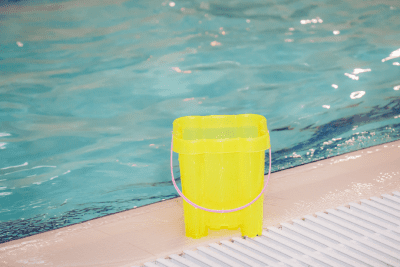Owning a pool is a dream come true – until you notice the water level dropping faster than it should. While some water loss is normal due to evaporation, a significant decrease might signal a pool leak. Here’s how you can find and repair that pesky leak, so you can get back to enjoying your pool.
How to Tell if Your Pool is Leaking
Before jumping into pool leak detection and repair, confirm that your pool is leaking. Here are a few signs to look out for:
- Unusual Water Loss: If you’re adding more water to your pool than usual, it could be a leak. Typically, pools lose about 1/4 inch of water daily due to evaporation. Anything more than that is cause for concern.
- Wet Spots Around the Pool: Puddles or damp areas around your pool could indicate a leak, especially if the ground stays wet even when it hasn’t rained.
- Decreased Chemical Levels: A leaking pool might also show lower-than-normal chemical levels. If you’re constantly adding chemicals to maintain balance, a leak could be the culprit.
- Air Bubbles in the System: If you notice air bubbles in your pool’s return jets, this could be a sign of a suction-side leak in the plumbing.
How to Find a Pool Leak
Once you’ve determined your pool is leaking, it’s time to find out where. Here’s a simple step-by-step process to find the source of the leak:

- Perform the Bucket Test: The bucket test is a simple way to differentiate between evaporation and a leak. Fill a bucket with pool water and place it on a step so that it’s partially submerged. Mark the water levels inside and outside the bucket. After 24 hours, compare the levels. If the pool water level has dropped more than the water inside the bucket, you likely have a leak.
- Inspect the Pool’s Structure: Check the pool liner, tiles, and coping for any visible cracks, tears, or gaps. These are common areas where leaks occur.
- Check the Pool Equipment: Inspect the pump, filter, heater, and valves for any signs of leaks. Look for drips, damp areas, or corrosion around the equipment.
- Dye Test: If you suspect a specific area, you can use a pool dye tester. Release a small amount of dye near the suspected leak while the pool is still. If there’s a leak, the dye will be drawn towards it.
How to Fix a Pool Leak
Here’s how to fix a pool leak, depending on where it’s located:
- Structural Leaks (Cracks or Tears): For minor cracks in the pool’s structure, you can use pool putty or a patch kit. Clean the area around the crack, apply the putty or patch, and smooth it out. For larger structural issues, call a professional.
- Plumbing Leaks: If the leak is in the plumbing, such as the pipes or fittings, you’ll need to locate the specific area and repair or replace the damaged section. This may involve digging to access underground pipes, so it’s often a job for a pro.
- Skimmer Leaks: Skimmer leaks are common and often easy to fix. Check for cracks around the skimmer and apply pool putty to seal them. If the skimmer is damaged beyond repair, it may need to be replaced.
- Liner Leaks: For vinyl-lined pools, patching a small tear with a vinyl repair kit is usually sufficient. Ensure the area is clean and dry before applying the patch.
- Pool Equipment Leaks: If you find leaks around the pump, filter, or heater, it may be as simple as tightening connections or replacing O-rings and gaskets.
Call Coastal Pools
While some pool leak repairs are DIY-friendly, others might require professional help. If you can’t locate the leak, if it’s in the underground plumbing, or if the damage is extensive, call in a pool repair expert. Coastal Pools has the equipment and expertise to get your pool back in shape.







